I've ordered a vibration capable PC gamepad, your generic xbox 360 style layout and it should be arriving sometime next week. As far as haptic feedback goes the controller comes equipped with 2 rotary vibration motors, a highfrequency one and a low frequency one. I'm going to use SDL 2.0 and its SDL_Haptic commands to access the gamepad (as well as handling a few other features). The issue is that I've been searching for the past couple of days for a tutorial about how to create descriptive rumble feedback. I've been abe to intuitively figue out a few things like if your character swings a big heavy hammer and it hits something you can use a short pulse from the low frequency motor to help with immersion. On the other hand a short pulse from the high frequency motor might represent blocking a sword blow. On the other hand if you are playing in a game with a modern setting, a vibration pattern can compliment a your character's cellphone ringing.
The problem is that despite how much I've looked I cannot seem to find a tutorial describing a few simple effects, and I know from experience that bad rumble is worse than no rumble in just about anything other than a shooter.
So, to get to the point do any of you know where a tutorial about how to use Rumble, rather than just how to implement it?
Thank you





